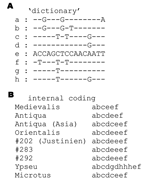Volume 11, Number 8—August 2005
Letter
Yersinia pestis Genotyping
To the Editor: Drancourt et al. (1) report the development of an original genotyping system for Yersinia pestis based on intergenic spacer sequencing. However, the approach appears to rely upon the characterization of polymorphisms due to tandem repeat variation. Eight spacers are used in the report, 7 of which contain tandem repeats, and the sequence variability used to produce the typing data and the strain clustering result from variation in the number of tandem repeats (and incorrect data analysis produces a dendrogram with 34 branches from only 19 different isolate types). Three of the spacers and associated polymorphisms were previously reported. Spacers YP3 and YP5 are, respectively, ms38 and ms56 (2); spacer YP10 is M61 (3). YP3 is later used to investigate ancient DNA samples, and 3 amplification products are described in detail. The sequences are compared to modern sequences by BLAST analysis, which is not relevant for tandem repeats. Instead, the Figure shows how internal variation within the array can be coded to facilitate interpretation. In this collection, Orientalis strains are "abcdeeef," whereas Antiqua strains from Africa are "abcdeef." All these different codes can be deduced one from the other by simple duplication and deletion events, with no need to invoke point mutations. The codes for all 3 ancient samples are identical to the Orientalis code "abcdeeef."
In conclusion, the data presented by Drancourt et al. do not appear to support their claim. They did not invent a new genotyping method but used the well-known multiple locus variable analysis (MLVA) number of tandem repeats approach. The finding that the "genotype Orientalis was involved in all three pandemics" is not valid since the Orientalis type is defined by a biochemical assay, resulting in all known Orientalis strains from a 93-bp glycerol-3-phosphate dehydrogenase microdeletion (4,5), which was not investigated here.
References
- Drancourt M, Roux V, Dang LV, Tran-Hung L, Castex D, Chenal-Francisque V, Genotyping, Orientalis-like Yersinia pestis, and plague pandemics. Emerg Infect Dis. 2004;10:1585–92.PubMedGoogle Scholar
- Le Flèche P, Hauck Y, Onteniente L, Prieur A, Denoeud F, Ramisse V, A tandem repeats database for bacterial genomes: application to the genotyping of Yersinia pestis and Bacillus anthracis. BMC Microbiol. 2001;1:2. DOIPubMedGoogle Scholar
- Klevytska AM, Price LB, Schupp JM, Worsham PL, Wong J, Keim P. Identification and characterization of variable-number tandem repeats in the Yersinia pestis genome. J Clin Microbiol. 2001;39:3179–85. DOIPubMedGoogle Scholar
- Motin VL, Georgescu AM, Elliott JM, Hu P, Worsham PL, Ott LL, Genetic variability of Yersinia pestis isolates as predicted by PCR-based IS100 genotyping and analysis of structural genes encoding glycerol-3-phosphate dehydrogenase (glpD). J Bacteriol. 2002;184:1019–27. DOIPubMedGoogle Scholar
- Pourcel C, Andre-Mazeaud F, Neubauer H, Ramisse F, Vergnaud G. Tandem repeats analysis for the high resolution phylogenetic analysis of Yersinia pestis. BMC Microbiol. 2004;4:22. DOIPubMedGoogle Scholar
Figure
Cite This ArticleRelated Links
In Response: We thank Dr. Vergnaud for his response (1). Since the time of our publication (2), 2 articles related to our paper were either submitted or published. One (3) reported identification of Yersinia pestis–specific genes in teeth from patients who died during the Justinian plague; another proposed identification of Y. pestis strains by using variable numbers of tandem repeats analysis (VNTR) (4). The authors concluded that isolates could easily be compared in their database by using 7 markers. As opposed to work with cultures where ample, high-quality DNA template is available, successful amplifications with 7 different primer sets cannot be achieved by using DNA extracted from ancient teeth (5). By comparing genome sequences, we evaluated short intergenic spacers that were more divergent. Divergences included mutations, deletions, and duplications (VNTR). Phylogenetically, an entire repeat unit has the same weight as that of a single nucleotide polymorphism. By sequencing, we have identified all events (single nucleotide polymorphism and VNTR). Sequencing is more versatile for use in strain identification (5), allows distinction at the species level, and can be applied directly on clinical and forensic samples.
[[AA:F21:PREVIEWHTML]]The discovery of a unique sequence is critical to authenticate results in such controversial areas as paleomicrobiology (5). Fortunately, we have identified a unique sequence that contains several mutations. These mutations do not exclude this strain from being Y. pestis (see Figure). Additionally, we doubt that our conclusions would have been accepted had we simply used the VNTR, demonstrating only an amplicon of the right size on a gel.
In conclusion, our results have been validated by others. The sequence is original and, therefore, authentic. Dr. Vergnaud agrees that the results we presented did represent a sequence associated with the Orientalis biovar. This finding may end the controversy.
References
- Drancourt M, Roux V, Dang LV, Tran-Hung L, Castex D, Chenal-Francisque V, Genotyping, Orientalis-like Yersinia pestis, and plague pandemics. Emerg Infect Dis. 2004;10:1585–92.PubMedGoogle Scholar
- Weichmann I, Grupe G. Detection of Yersinia pestis DNA in two early medieval skeletal finds from Aschheim (Upper Bavaria, 6th century AD). Am J Phys Anthropol. 2005;126:48–55. DOIPubMedGoogle Scholar
- Pourcel C, Andre-Mazeaud F, Neubauer H, Ramisse F, Vergnaud G. Tandem repeats analysis for the high resolution phylogenetic analysis of Yersinia pestis. BMC Microbiol. 2004;4:22. DOIPubMedGoogle Scholar
- Drancourt M, Raoult D. Paleomicrobiology: current issues and perspectives. Nat Rev Microbiol. 2005;3:23–35. DOIPubMedGoogle Scholar
Table of Contents – Volume 11, Number 8—August 2005
| EID Search Options |
|---|
|
|
|
|
|
|

Please use the form below to submit correspondence to the authors or contact them at the following address:
Gilles Vergnaud, Department of Analytical Microbiology, Centre d'Etudes du Bouchet 91710, Vert le Petit, France; fax: 33-1-69-15-66-78
Didier Raoult, Unité des Rickettsies, Faculté de Médecine, 27 Bd Jean Moulin, 13385 Marseille Cedex 05, France; fax: 33-4-91-38-77-72
Top